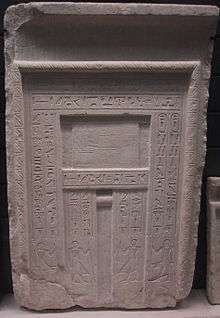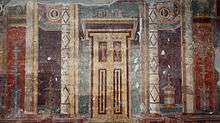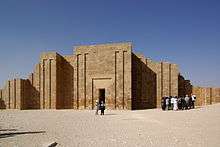False door


A false door is an artistic representation of a door which does not function like a real door. They can be carved in a wall or painted on it. They are a common architectural element in the tombs of Ancient Egypt and Pre-Nuragic Sardinia. Later they also occur in Etruscan tombs and in the time of Ancient Rome they were used in both the interiors of houses and tombs.
Ancient Egypt
The Ancient Egyptians believed that the false door was a threshold between the worlds of the living and the dead and through which a deity or the spirit of the deceased could enter and exit.[1]
The false door was usually the focus of a tomb's offering chapel, where family members could place offerings for the deceased on a special offering slab placed in front of the door.[2]
Most false doors are found on the west wall of a funerary chapel or offering chamber because the Ancient Egyptians associated the west with the land of the dead. In many mastabas, both husband and wife buried within have their own false door.
Structure
A false door usually is carved from a single block of stone or plank of wood, and it was not meant to function as a normal door. Located in the center of the door is a flat panel, or niche, around which several pairs of door jambs are arranged—some convey the illusion of depth and a series of frames, a foyer, or a passageway. A semi-cylindrical drum, carved directly above the central panel, was used in imitation of the reed-mat that was used to close real doors.
The door is framed with a series of moldings and lintels as well, and an offering scene depicting the deceased in front of a table of offerings usually is carved above the center of the door.[1] Sometimes, the owners of the tomb had statues carved in their image placed into the central niche of the false door.
Inscriptions
The side panels usually are covered in inscriptions naming the deceased along with their titles, and a series of standardized offering formulas. These texts extol the virtues of the deceased and express positive wishes for the afterlife.
For example, the false door of Ankhires reads:[3]
- "The scribe of the house of the god's documents, the stolist of Anubis, follower of the great one, follower of Tjentet, Ankhires."
The lintel reads:
- "His eldest son it was, the lector priest Medunefer, who made this for him."
The left and right outer jambs read:
- "An offering which the king and which Anubis,
- who dwells in the divine tent-shrine, give for burial in the west,
- having grown old most perfectly.
- "His eldest son it was, the lector priest Medunefer,
- who acted on his behalf when he was buried in the necropolis.
- The scribe of the house of the god's documents, Ankhires."
Historical development
The configuration of the false door, with its nested series of doorjambs, is derived from the niched palace façade that became a common architectural motif in the Predynastic period and the Old Kingdom.[4] The false door was used first in the mastabas of the Third Dynasty of the Old Kingdom, and its use became nearly universal in tombs of the fourth through sixth dynasties. During the nearly one hundred and fifty years spanning the reigns of the sixth dynasty pharaohs Pepi I, Merenre, and Pepi II, the false door motif went through a sequential series of changes affecting the layout of the panels, allowing historians to date tombs based on which style of false door was used.[5]
After the First Intermediate Period, the popularity of the false doors diminished, being replaced by stelae as the primary surfaces for writing funerary inscriptions.
Prehistoric Sardinia
In Domus de Janas, chamber tombs of the pre-Nuragic Ozieri culture, there are often false doors carved in the walls, supposed to be entrances to the Underworld.[6][7][8]
Etruria
In Etruscan tombs the false door has a Doric design and is always depicted closed. Most often it is painted, but on some occasions it is carved in relief, like in the Tomb of the Charontes at Tarquinia. Unlike the false door in ancient Egyptian tombs, the Etruscan false door has given rise to a diversity of interpretations. It might have been the door the underworld, similar to its use of the ancient Egypt. It could have been used to mark the place where a new doorway and chamber would be carved for future expansion of the tomb. Another possibility is that it is the door of the tomb itself, as seen from outside. In the Tomb of the Augurs at Tarquinia two men are painted to the left and right of a false door. Their gestures of lamentation indicate that the deceased were considered to be behind the door.[9]
Ancient Rome

Painted doors were used frequently in the decoration of both First- and Second style interiors of Roman villas. An example is the villa of Julius Polybius in Pompeii, where a false door is painted on a wall opposite a real door to achieve symmetry. Apart from creating architectural balance, they could serve to make the villa seem larger than it really was.[10]
See also
References
- 1 2 Bard, KA (1999). Encyclopedia of the Archaeology of Ancient Egypt. NY, NY: Routledge.
- ↑ Allen, JP (2000). Middle Egyptian. Cambridge UK: Cambridge University Press. p. 95.
- ↑ Strudwick, Nigel C. (2005). Texts from the Pyramid Age. BRILL. p. 239.
- ↑ "False door". ucl.ac.uk.
- ↑ Strudwick, Nigel (1986). The Administration of Egypt in the Old Kingdom. Kegan Paul.
- ↑ Lilliu, Giovanni (1988). La Civiltà dei Sardi. Nuova ERI.
- ↑ Demartis, Giovanni Maria (1986). La Necropoli di Anghelu Ruju. Carlo Delfino editore.
- ↑ http://www.neroargento.com/page_galle/sincantu_gallery.htm
- ↑ Jannot, Jean-René (2005). Religion In Ancient Etruria. Madison, Wisconsin: University of Wisconsin Press. p. 56. ISBN 978-0-299-20844-8.
- ↑ Clarke, John R. (1991). The Houses of Roman Italy, 100 B.C.–A.D. 250: Ritual, Space, and Decoration. Berkeley and Los Angeles, California: University of California Press. pp. 113–115. ISBN 978-0-520-08429-2.
Further reading
- Owen, Maurice (24 February 2010). "False - Doors". The False-Door : dissolution and becoming in Roman wall-painting. Southampton Solent University. Retrieved 28 July 2013.
External links
| Wikimedia Commons has media related to False door. |

